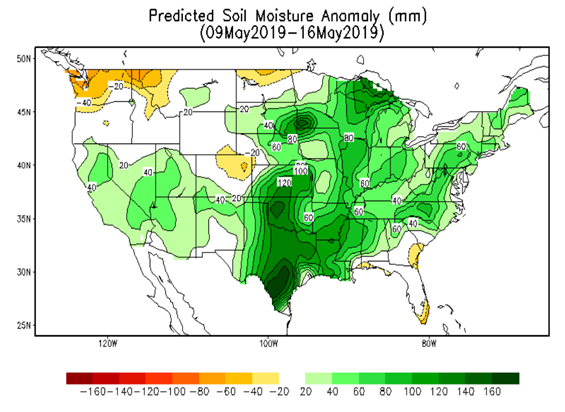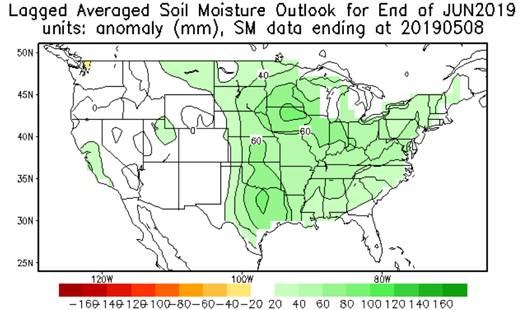DTN’s senior ag meteorologist, Bryce Anderson, last week shared his latest expectations for the 2019 growing season. To jump to the bottom line, he sees the cool, wet weather lingering into the end of May through the entire central U.S.
Not only is it keeping farmers from the field but disrupting transit of grain exports and fertilizer movement north to farmers, many of whom already anticipated a crunch due to field work that didn’t get done last fall. The Mississippi River broke its 1993 record and is cresting a second time.
“Flooding will continue to be a problem through the entire season – especially in the Western Corn Belt- he said. “Some fields were too damaged to plant this year, for instance.” Comparing this year with analog years 2013 and 2015, Anderson expects prevented plantings to total in the 2-3 million area, well above the 1.5 million average. Virtually all spring crops could be affected.
The Climate Prediction Center’s map shows northeast Kansas is expected to receive almost 4” (100 mm) of more rain than normal between May 9 and May 16 , suggesting continued delays are possible.

“However, once the crops are in the ground, growing conditions promise to be quite favorable,” he added. There is a weak El Niño (1o to 2.5o C above normal) in the Pacific Ocean, and it likely will remain in place through the growing season and possibly through the year. El Niño is associated with fewer than normal threats to U.S. summer crops, Anderson explained. On the downside, it could mean another wetter than usual harvest period, though “probably not as bad as last year.”
For more information, contact Bryce Anderson with DTN.
Again, the Climate Prediction Center’s outlook maps for the end of June (shown) and even August project 1.6”-2.4” (40 to 60 mm) more soil moisture than usual.

Kansas progress
In the week ended May 6, there we three days when some fieldwork could take place, according to USDA. Corn in the 18 reporting states was only 23% planted, compared with a five-year average of 46%, and 6% of so9ybeans were in the ground compared with 14% on average. Kansas corn planting was ahead of some states, but at 41% was behind its 51% average; soybeans came closer to average with 5% planted, one percentage point behind normal.
The eastern part of the state was well ahead of the total: northeast, 56%; east central, 55% and southeast, 56%.
On the plus side, winter wheat yields appear to be strong, based on crop tours ahead of harvest. The Kansas Wheat Quality Council pegged yields at 47.2 bu./acre, well above the five-year average crop tour estimate of 40.2 bu., and last year’s 38 bu.
But crop watchers worry that the crop is running late and prolonged excess moisture could cause problems before harvest is able to commence.
Late Plantings
A conservative estimate for national late corn planting this year is at least 5-10 percent above the long range (1980-2018) average of nearly 17%, according to University of Illinois ag economists Scott Irwin and Todd Hubbs.
They note that years with especially high late planting (2013, 2002, 2009, 1996, 1993, and 1995, in that order),
Impact on yield
Irwin reported five of the six years (19934, 1995, 1996, 2002, 2013) with 30% of the corn crop left to plant after May 20 resulted in about a 6 bu./acre drop in the national average yield versus trend. (2009 saw an above-trend yield.) Based on those analog years, their analysis suggests national yields well below the 175.4 bu. trend yield: 169.3 bu. based on all the years between 1980 and 2018 with 10 percent or more planted late, and to just 168 bu./acre based on years with very late planting (1995, 1996 and 2009).
Click for more analysis on how many acres may be involved and potential impacts on the crop.
Caveat: Fast planting
A recent Farm Journal Pulse poll released May 2 asked farmers how long it takes to plant their crops in perfect conditions. Forty-two percent said they can do it in less than 10 days. Mark Licht, an agronomist at Iowa State University, calculates corn planting peaks between 1 and 1.25 million acres a day (just over 13 days to plant this year’s Prospective Plantings) and about 14 days to plant all the soybeans.
But weather forecasts, including Anderson’s, don’t show that many good field days in the next few weeks. In addition, Anderson added that many fields are slow to dry out even when it isn’t raining, given the saturation and lack of sunshine.
Answers to questions
If you anticipate planting problems, contact your Frontier Farm Credit crop insurance officer for guidance on prevented planting, replanting, late planting, cover crops and related issues.

